Director Andrew Thomas Huang interviewed
Past holographic women buzzing in electric mauves and garish greens, past Chinese artists scribbling grey scale not-quite-likenesses of tourists, and just beneath golden arches and beaming advertisements for shamrock shakes, the crowd’s arms stretch nervously before them, iPhones testing the light-polluted air like the knobbed feelers of hypersensitive snails. It is 11:55 pm, and a street artist is at work in Times Square. Beneath him lies a blackened canvas gessoed with spray paint.

Fumes hiss off the paper into nostrils, and some cover their mouths. At 23:56, the artist produces a joint knife and bends it to the canvas like a military instrument. Streaks of red, blue and orange light begin to poke through the black world. At 23:57, 80 monitors towering above the artist begin another refrain entirely.
In the video for “Mutual Core,” Björk appears vertiginously costumed, sunk amidst grappling sediment. From the sand come rocks; from the rocks, tongues whose layers lap at each other but struggle to connect. Skeins of moss and hair wind between the bodies, stretching. A growing profusion of expressive colour seems to make the attempt at union only more desperate.
At 23:58, the street artist’s palette is bursting from charcoal to white-hot orange, deep purple, black and blue. A cityscape emerges in the spaces whittled by the joint knife. Rocks splash into sands active like wood chippers in the video above, and the crowd’s attention flits between the monitors’ frenzy of graphics and the artist’s own hand braying layers of the painted blindfold.
With a large ruler he wipes the bottom of the paper white as teeth. At 23:59, he reaches for another can of paint just as above him Björk’s “unspent capsule” of energy explodes. The compressed bodies volcanically erupt; at 00:00, lava flows like sloe gin down their pied tectonics in a world absent of lyrical sound once more.
In the credits, beside Björk’s name, “ANDREW THOMAS HUANG” glows.
Throes of creation
Out in the wilderness beyond Reykjavík lies a lot of sand. Buckets of it—whole truckloads, even, in the mining areas. Driving through the countryside with a production assistant at shotgun, Director Andrew Thomas Huang imagined himself sifting his hands in thrall through the beautiful, plum-black mixture. They would stop the car while he did this, collecting sand samples of all sorts. But even as he did so, Huang felt the artist in him rankling, polarizing—felt certain that of all the sands in Iceland, only seashell-collared sands would match the aesthetic he was carefully rigging for Björk’s video.
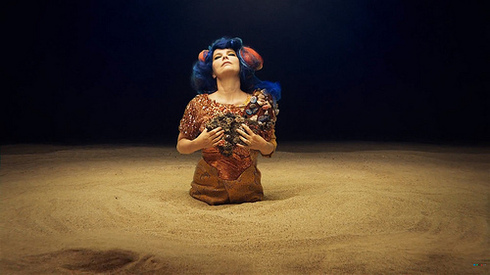
So the car departed to bottle more samples decomposed from the milky stuff that shields crustaceans from predators in the sea. In separate trips, they cribbed still more from the landscape: moss, green sprigs, and some baked yellow on the sun-heated rock. After that, they took the rocks themselves.
Huang’s native soil is in the American Southwest, where from a young age his creative imagination was filtered through a prism of red mesas, expansive blue skies and earthy, yellow crust. While this bright palette doesn’t define Huang—his breakout video during film school, “Doll Face,” features a robot whose ashen gears attenuate and fray in pursuit of puerile shades of lipstick—it has nevertheless provided the basis for his recent successes including “Solipsist,” a ten-minute short that sketches a world of synaptic distance between individuals—a world in which Björk, the artist, wanted to exist.
To open that dimension for Björk—to create a new space in the aesthetic of “Solipsist”—Huang had to attack his first impulses and suss out the complexity of “Mutual Core” and Björk’s own sensual presence. As he explains it, this is precisely the rhythm that pounds out in the execution of any music film.
“Maybe you hear a song and suddenly there’s a visual cliché in your head—‘Oh, I picture her hair blowing in the wind and she’s riding on the back of a pick-up truck.’ And then you come back to yourself with, ‘No, no, don’t do that. Or yeah, do that, but what ways are there to make it more specific?’”
Acknowledging that this was a “volcanic song,” he followed his dissatisfaction from the flat, science diagram-like tectonic plates in his early sketches to something more active—to various lively drawings and Photoshop collages that grew less and less “stupid” with each draft. For materials, he chose sand, but not the black sand.
“It’s funny because growing up in Los Angeles, I always fantasized about the other side of the Atlantic—about Scotland and the Highlands and that whole part of the world. But when I came to Iceland—away from Los Angeles, where those colours come so naturally—I had this need to fabricate them,” he says.
“I was trying to fight against the typical colour that surrounds you there.”
Toxic, bitter glue
Sagafilm studio’s headquarters at Laugavegur 176 are set in precisely the kind of geometric building whose sanded white surfaces and Barbasol-blue windows occupy the concept of “Scandinavian” in the American imagination. It was into this building that Huang directed ton after ton of his precious seashell-collared sand for the video shoot with Björk.
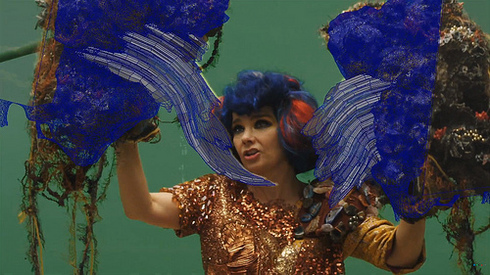
At the time, there were about four feature film productions shooting in Iceland. Accordingly, most of the film community was booked. With just enough film and art direction staff to operate on a low budget, Huang got to work.
As Huang’s collared storyboards had it, not only Björk but a bevy of huge rocks sculpted in foam—imitating those plucked from Iceland’s landscape—would course in the sand as if upon waves.
“We wanted the rocks to kind of move around in the sand. I wanted them to feel like whales—like a herd of whales rising in and out of the sand,” he says. “But sand is formidable to deal with. It’s heavy, and once you take something out of it, you can’t really shove it back in.”
Compounded with the sand’s great weight were new errors. Huang had brief battles with the art directors over how the rocks should look—“everyone in Iceland seems to have a very clear idea in their head what lava and lava rock look like”—and how the lava should be concocted.
In Huang’s conception, “lava” could easily be sourced from dye and cake batter. Perhaps, in fact, simple food colouring was all that was needed. He was surprised, then, to hear his team probe him about the chemistry he planned for his mixture. Speaking to Icelanders about volcanic matters, he “wound up sounding entirely nonspecific.” So he listened to the people who’d sprouted beside volcanic soil, even as their need for a “specific consistency” seemed needlessly obdurate at first.
While the lava caucus haggled in Sagafilm’s backroom, Huang deployed widely divergent skills to shore up the puppetry rigging in the front. The first step was creating a platform in which to bury Björk. The next steps were to marshal a system of ropes and lines to orbit and enliven the foam rocks on set. Even if the rocks couldn’t be made to dance like whales until post-production, Huang knew some of his smoky vision had to be coaxed out of the bottle without computer help.
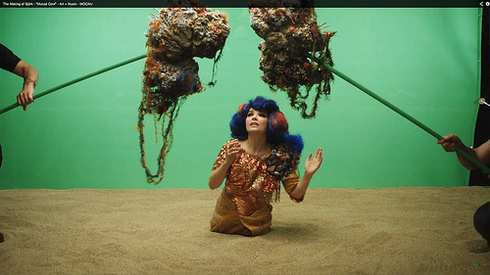
In reality, Huang is at least as gifted a puppeteer as he is a producer and animator. Growing up in Los Angeles, an early hatred for sports and the sun blossomed into opportunities like he had at age nine, when he learned puppetry from Jim Henson’s crew in a now-defunct after-school initiative.
“Not only did they teach us how to do puppetry, but how to actually work with these really toxic materials. How to make puppets out of special foam, how to use toxic, bitter glue to make patterns, how to make a sphere out of foam by cutting orange peel slices and pasting them together,” he says. “It was basically an introduction to making sculpture—but making sculpture that had to move in a certain way.”
Watching the Star Wars films around the same age, he would “freakishly study” the objects they used for X-wing fighter planes and the Death Star. He wanted to know how George Lucas’s team did what they did and how he could replicate it.
Experience with puppetry moulded his early artistic development and guided his application to film school. And it continues to crystallize in his oeuvre—including the world created to house the production “Solipsist.”
In the first scene of “Solipsist,” clipped fragments of hair, fabric, and painted, sequined paper sprout serpent-like from the shoulders between two dancers seated back-to-back. As their backs writhe and lunge together—attempting singular motion—blue feelers like a sea anemone’s and pink pouches glide into what are now wreaths around each dancer’s neck. Feathers spread beneath their hair to reach the space around their ears, and soon finger-like creatures spread in Technicolor like gummy worms to encase both dancers in a precursor to the tectonic “mutual core.”
In the second scene, the union is imagined on a more abstract level. Puppets ingeniously devised operate in a space underwater, yet immaterial. Beautiful and weird, creatures red, yellow and blue like fishing lures chirrup a chorus of R2-D2-esque beeps and shock to connect to one another—in Huang’s word, “synaptically.” Even as the dancers’ bodies remain entwined in the earliest deposited layer of the film, “violent” and “kinetic” battle is being waged at one still deeper.
“I think “Solipsist” is focused on this idea of spatial division between two coordinates—that between one person and another, the void is elastic and ever-expanding,” Huang says.
“What does it mean when two people are touching? Where is the skin? How are both skins touching each other? Your nerve endings are a series of chains of cells, and between all those cells is a series of chains of more cells, and between each of those cells is a necessary gap. Information and electricity pass through that gap—a gap that “Solipsist” explores.”
The symbolism intensifies with further scenes in “Solipsist,” but it is the middle, “synaptic” section Huang remains “most proud of.” With abstract, highly technical puppetry he succeeds in evoking the crackling violence belying even basic human interaction. And it is this scene that he knew he wanted to bring back to Björk—this scene that gave him the “impetus” to evolve the fishing lure creatures into rock puppets in the music video.
Back in the studio, Huang and his art directors have decided on the chemistry for their lava mixture. For the right splatter patterns, they tilt a specific consistency of pancake batter in with ketchup and “some other little bits.” More than the science diagram-like depictions of tectonic plates, “Mutual Core’s” universe is growing into something “violent, bigger, grander” than even the world Huang quickened in “Solipsist.”
A human touch
When Björk saw “Solipsist,” Huang thought, she responded to its minimalism—the fact that it takes place in a “black void.” She responded, he thought, to the “elasticity” of the distance between two coordinates, and to the invisible “polarities” which alternately coax them toward union and finally repulse them.
She responded above all, he thought, to the idea of violent and kinetic motion he’d put forth in scenes like that with the underwater creatures.
So when he began directing her in the smoky red scene that splices into the action’s final cataclysm, he told her to dish it to him violently. In what he considered a “ferocious” and “volatile” part of the song, he wanted her to give way to her “anger.”
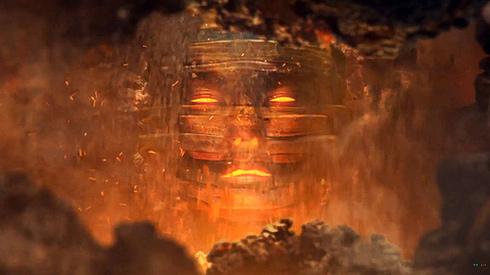
With the red light glaring and fake smoke spewing on the set, Björk, did her best to channel the anger Huang wanted. But after a few takes failed to stick, she gave up and broached with him what she thought was the song’s deeper emotion.
“She said, ‘I think performing this as if I were angry is a bit too simplistic. This song is about eruption, and eruption is actually something that makes me happy.’”
For Björk, volcanic phenomena have a “positive” significance—so, too with “Mutual Core.” Huang immediately saw her point. In ‘Biophilia,’ an album celebrating destructive phenomena and the invisible polarities that attend them, Björk was in fact operating at a “genius” double-remove—not in thrall of mere destruction but open to a broader picture: one in which even tectonic-scorched earth fuels the planet’s never-ending cycles.
The movement of tectonic plates—“as fast as your fingernail grows,” in Björk’s lyrics—can occupy centre stage in a drama that captures time on the correct scale. After Huang’s discussion with Björk on the slight directorial axis of “anger” in her video, they both opened up more. Björk became more “playful” during and between takes. She enlivened the part of “Mutual Core” that Huang calls “romantic and sensual.” And even if he continued to pull his hair out during the protracted struggles of managing a set, Huang felt more at ease with himself now that he understood her vision. He took the puppeteer’s reins and commanded his smoky vision to marshal before him.
Björk remained nothing if not “hardy.” She sat for seriously dense costume and make-up application that worked her eyes black, her hair blue and her skin golden-scaled. She stood half-submerged in Huang’s precious sand for hours at a time. She even consented to froth the mix of ketchup and pancake batter in her mouth and spit it so Huang could finesse the take into a later animation.
In the “making-of” video for the production, she smiles without fail.
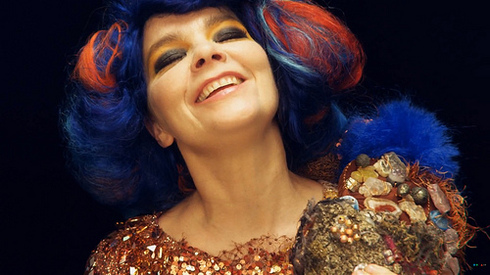
“This is just my projection, but I don’t think Björk wants to be treated delicately,” Huang says. “She’s a fine artist and performer herself, so she’s pretty hardy. Her husband is pretty hardy. They’re like tough, working artists. It wasn’t a problem for her to get on her hands and knees to do what we needed her to do.”
This fact benefitted Huang, working as he was on a limited budget with few crew members and even fewer hours to dedicate to filming. After rehearsing the production so many times in his head—and so many times across storyboards bleeding with expression— Björk completed the circuit with still more energy in her performance.
But if their connection on set was electric, the feeling for Huang after time ran out was that of a hand unclasping.
“It was such an ambitious shoot and such an ambitious shot list that at some point, you knew it was time to just let go,” he recalls.
Post-Production
When the shooting was finished, Huang flew home to Los Angeles and into a flurry of post-production edits. Unique among most directors, he has a flare for animation which allows him to undertake most of this work himself.
And yet, if he felt security while directing on set—“I know if something isn’t 100% working, I can still fix it”—the work to achieve his singular vision after the fact was nothing short of titanic.
For tens or even hundreds of hours, he protected and fought for this vision in private—sent out his knobbed feelers over the dials of his computer, adding a touch of color here, a flourish of anemones there. The struggle, as he put it, was to add to his puppetry “a human touch.” To the rocks and layered tongues, he didn’t want to give “eyes, or mouths.” Instead, he wanted them to “feel” like the “human hands operating them,”—even if “you can’t quite tell what the hell they are.”
“Violent” and “kinetic” remained; but with Huang’s direction, they moldered under a conceptual framework of “romantic” and “sensual” that was allowed to thrive. As he worked, contracted into the seashell conclaves of his own mind, Björk continued to reach out to him. She told him how happy she was with the shoot, and forwarded him a short story she recalled only after the production was finished.
In Italo Calvino’s story “Without Colors,” part of the collection Cosmicomics, the hero Qfwfq falls in love with and pursues the beautiful Ayl. Before an atmosphere has formed to filter the sun’s light—before color has forever imbued collecting gases with the differentiation of higher mathematics—there is only grisaille:
“Trees of smoke-colored lava stretched out twisted branches from which hung thin leaves of slate. Butterflies of ash flying over clay meadows hovered above opaque crystal daisies…”
When the landscape begins to roil under the influence of greenhouse gases, Ayl retreats, frightened into the chasms of the earth. Though he gives chases, Qfwfq is ultimately parted from her. His thirst for contrast—for violence and soundscapes—leaves him stranded irrevocably among the “canary-yellow fields which striped the tawny hills sloping down to a sea full of azure glints.”
To Huang, this tyranny of color—the individuation it inspires and the compromises between two bodies it thwarts—seemed just as important as the “romantic” and “sensual” nuance Björk teased out between eruptive forces. Reading the story, he sensed acutely once more how distances between one object and another—even between one gender and another—only multiply when specificity creates distinction and when colors sprawl and tangle in rainbows between every point on a sphere of polarities.
With his art, Huang sought to temper the gothic blacks and greens in what Iceland represented to his imagination. Looking upon the black, synaptic space of Huang’s earlier work, Björk sought to open a new dimension for herself and her art with the video. In Manhattan, working beneath 80 monitors beaming their mutual creation and lyrical sound, the street artist continues to spray and brush the heat onto his canvas.
And so the biosphere rotates.
Buy subscriptions, t-shirts and more from our shop right here!















